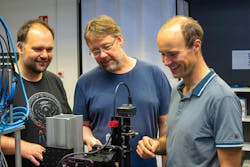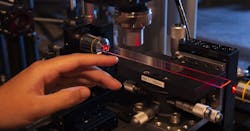Can topology help transmit and process quantum information?
A group of researchers led by Alexander Szameit, a physics professor at the University of Rostock in Germany, paired the topologically robust properties of light with the interference of photon pairs. And they discovered topology—an abstract mathematical concept initially developed to classify solid geometries by their global properties—is also valid within the quantum realm (see video).
Light follows the global characteristics of the waveguide system within topological systems. Even perturbations to the waveguides such as defects, vacancies, and disorder won’t divert its path.
This work, which was a collaboration with colleagues from the Albert Ludwig University of Freiburg, opens numerous intriguing questions involving topological robustness of entanglement and even nonlocal topological effects. It’s a big deal because topology may soon play a key role in the transmission and processing of quantum information.
Szameit’s group explores integrated photonic waveguide circuits and quantum light. “Originally, we used classical light for quantum simulations of solid-state phenomena,” he says. “But we realized there’s much to be discovered by extending our research to the quantum features of light, such as entanglement and nonlocality. This is when it started, out of curiosity, 12 years ago. Everyone should remember the name of Max Ehrhardt, my Ph.D. student who did the work, because he has a truly ingenious mind.”
Hong-Ou-Mandel interference meets topological photonics
The quantum effect the team’s experiment is based on is Hong-Ou-Mandel interference. In 1987, the three physicists observed the behavior of photon pairs within a beam splitter during an experiment and found that a photon, which interferes with itself due to its behavior as an electromagnetic wave, can also form interference patterns with other light particles. Beyond entanglement as a fundamental feature of quantum light particles, this groundbreaking discovery is an ingredient for optical quantum technologies, including quantum computers.
“Two indistinguishable photons enter a network and bunch up,” explains Szameit. “When they enter a beam splitter from different sides they will always exit it together—although we can’t tell which side of the beam splitter the pair will exit. This effect is rather fragile: the splitter requires a perfect 50/50 splitting ratio, and any deviation immediately results in a degradation of the bunching.”
Topological photonics is another topic Szameit and colleagues have focused on for 10 years. “By using topological concepts, we can generate light waves that are robust to distortions, which means they can travel even around corners and defects,” he says. “Our idea was to combine both effects to get topologically protected Hong-Ou-Mandel interference.”
Design work: An artificial dimension
To implement this idea, the team turned to an artificial dimension. “We used the polarization degree of freedom of light,” says Szameit. “It allows us to implement a three-dimensional (3D) system, although the waveguide circuit has only two dimensions (width and length). Height is emulated by the polarization. It’s a very general concept, but such ‘synthetic dimensions’ allow us to go beyond the constraint of only three spatial dimensions.”
The biggest step toward their findings “was the development of a synthetic polarization dimension in waveguide circuits,” Szameit says. “As we became more experienced, we discovered the features of this synthetic dimension allow us to implement various photonic systems by judiciously tailoring this birefringence of each waveguide.”
Among the features, the team found photons can behave as if they are affected by a gauge field with quantized magnitude, which is established by topology within the synthetic polarization dimension. “It was the breakthrough we needed to implement topologically protected quantum interference,” Szameit says.
The researchers were seriously impressed by the level of robustness of quantum interference introduced when they implemented topological protection. “We couldn’t believe it when we saw it in the measurements: but even when we had very strong deviations from the ideal beam splitter, we were still able to observe the quantum interference almost undisturbed,” says Szameit. “In conventional beam splitters, quantum interference would have vanished completely. It was only when we did the calculations that we realized that topology is an incredibly big gain here.”
Ehrhardt adds that topological protection of optical elements is a design tool necessary to ensure proper operation. He likens the odd behavior of the quantum nature of light when pairs of photons see each other to them perceiving the waveguide structure as twisted. And this photon pair ends up dancing along the twisted dancefloor as a couple.
“Photons that pass through the waveguide separately experience a conventional flat surface, so we have a topological difference,” Ehrhardt says.
Quantum interference applications ahead
Topologically protected Hong-Ou-Mandel interference can be used for any applications in which quantum interference is useful. “In particular, Hong-Ou-Mandel interference gives rise to ultraprecise measurements,” Szameit points out. “Time measurements, for instance, achieve attosecond precision, so a more reliable interference method might be able to boost the precision to another level.”
Another potential application is to generate and process quantum states for quantum computing. Quantum computers use “a large number of beam splitters to accomplish quantum interference so that small inaccuracies of the individual beam splitters are strongly reflected in the final result,” Szameit adds. “In this regard, topological protection of the Hong-Ou-Mandel interference will reduce the inaccuracies, which allows for bigger quantum circuits without compromising functionality. Eventually, it will bring us one step closer to a photonic quantum computer.”
What’s next? “New questions arose from our observation,” says Szameit. “First, are there other quantum effects that can benefit from the topological features of the synthetic polarization dimension? Can we establish similar topological features in other photonic synthetic dimensions such as frequency or orbital angular momentum of light? And, finally, can we find other stable topological effects of more than two photons if we use the topological features available in the synthetic polarization dimension?”
FURTHER READING
M. Ehrhardt, C. Dittel, M. Heinrich, and A. Szameit, Science, 384, 1340–1344 (2024); doi:10.1126/science.ado8192.
About the Author
Sally Cole Johnson
Editor in Chief
Sally Cole Johnson, Laser Focus World’s editor in chief, is a science and technology journalist who specializes in physics and semiconductors.


